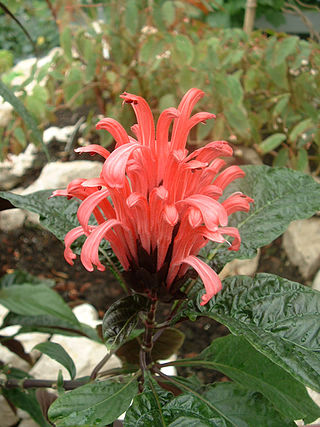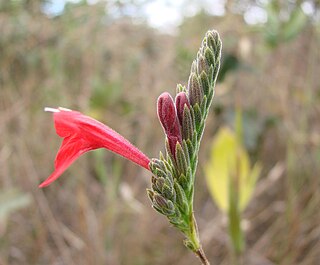
Justicia is a genus of flowering plants in the family Acanthaceae. It is the largest genus within the family, encompassing around 700 species with hundreds more as yet unresolved. They are native to tropical to warm temperate regions of the Americas, India, and Africa. The genus serves as host to many butterfly species, such as Anartia fatima. Common names include water-willow and shrimp plant, the latter from the inflorescences, which resemble a shrimp in some species. The generic name honours Scottish horticulturist James Justice (1698–1763). They are closely related to Pachystachys.

The Cerrado is a vast ecoregion of tropical savanna in eastern Brazil, being present in the states of Goiás, Mato Grosso do Sul, Mato Grosso, Tocantins, Maranhão, Piauí, Bahia, Minas Gerais, São Paulo, Paraná and the Federal District. The core areas of the Cerrado biome are the Brazilian highlands – the Planalto. The main habitat types of the Cerrado consist of forest savanna, wooded savanna, park savanna and gramineous-woody savanna. The Cerrado also includes savanna wetlands and gallery forests.
Justicia angustifolia is a plant native to the Cerrado vegetation of Brazil.
Justicia burchellii is an ornamental plant native of Cerrado vegetation of Brazil.
Justicia chrysotrichoma is a plant native to the Cerrado vegetation of Brazil. It is one of the species of flowering plants in the family Acanthaceae.
Justicia cynea is a plant native to the Cerrado vegetation of Brazil.
Justicia genistiformis is a plant native to the Cerrado vegetation of Brazil.

Justicia irwinii is a plant native to the Cerrado vegetation of Brazil.

Justicia lanstyakii is a plant native to the Cerrado vegetation of Brazil, first described by Rizzini in 1946.
Justicia nodicaulis is a plant native to the Cerrado vegetation of Brazil.
Justicia pycnophylla is a plant native to the Cerrado vegetation of Brazil.
Justicia sarothroides is a species of flowering plant native to the Cerrado vegetation of west-central Brazil.
Justicia serrana is a plant native to the Cerrado vegetation of Brazil.

Justicia aurea, the Brazilian plume or yellow jacobinia, is an ornamental shrub native to the Cerrado vegetation of Brazil. This plant may be propagated by herbaceous stem cutting, and it can usually get to 1,50 - 2,50 m tall. They flourish in the shade, and will not do well if overwatered.
Justicia warmingii is a species of flowering plant. It is native southeastern Brazil, where it grows in the Cerrado vegetation.
Justicia triloba is a species of flowering plant in the family Acanthaceae. It a shrub native to the Caatinga vegetation and Cerrado vegetation of Brazil, ranging from Tocantins to Piauí and Minas Gerais states.
Justicia oncodes is a plant native to the Cerrado vegetation of Brazil.
Justicia tocantina is a plant native to Argentine, and the Cerrado vegetation of Brazil. This plant is cited in Flora Brasiliensis by Carl Friedrich Philipp von Martius.
Alchornea triplinervia is a commercial timber tree native to Amazon Rainforest, Atlantic Forest, and Cerrado vegetation in Brazil. This plant is found in the following states of Brazil: Amazonas, Bahia, Espírito Santo, Goiás, Mato Grosso, Mato Grosso do Sul, Minas Gerais, Paraná, Rio de Janeiro, Rio Grande do Sul, Rondônia, Roraima, Santa Catarina, and São Paulo. It is also used as a honey plant.




